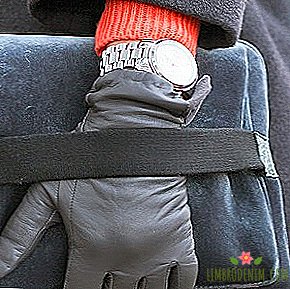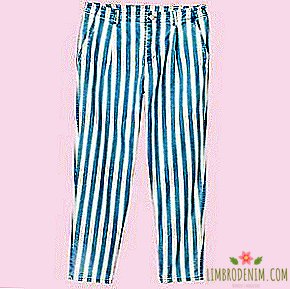Defect for export: Why the new Russian style came into vogue
"Although I am the author of the largest publications on this topic, I am a pessimistic prophet: Russian fashion is not! There is a Russian style in clothes: these are furs, diamonds, pearls, hats, bright combinations and certain forms of cut. I’m looking for in Russia not the superficial American influence in the midst of the hooliganism of the 1990s, but something more national, broader, more authentic. A shard fragment is not a work of art for me. However, I wish Gaucher (Rubchinsky. - Ed.) success, "- said fashion historian Alexander Vasilyev" Poster City "in early 2015.
This odious interview flowed into a wave of alarmist moods that were in the air due to the sharp weakening of the ruble. Of course, the economic crisis that began in 2014 had a number of more serious consequences than the difficulties of the Russian fashion industry. But it was because of him that everyone abruptly remembered that rich Russian clients made our luxury market one of the largest in the world and created the conditions for the emergence of domestic (most often not cheap) brands. This shaky new foundation could collapse overnight simply because people had less money. The question "What is actually with fashion?" It became abruptly topical, tied to patriotism, the division into “ours” and “aliens,” and the rapidly deteriorating financial situation did not at all contribute to the elegance of the discussion.
Politics does not form a fashionable agenda, but it creates an informational background, and in the case of Russia and the former USSR, this background is very charged.
Almost two years have passed since then, and the world has not collapsed. We began to spend money on things more carefully, some brands closed part of Russian boutiques or left our market altogether, and & Other Stories ceased to seem such a democratic brand (thanks to the euro for seventy-six). However, sales at TsUM are growing, most people have not abandoned Zara and H & M due to import substitution considerations, and Russian premium brands like Alexander Terekhov and Ruban work as they did. Not without difficulty, but everyone adapted to the new reality, and there is nothing to be surprised about. A surprise came from an absolutely unexpected side: whatever Alexander Vasiliev thought, Russia suddenly had a clear and loud fashion voice. So loud that it blocked almost everyone else on the international stage, and Rubchinsky’s mark, a “fragment of a fragment”, is at the forefront of this sudden triumph.
Russia and Russian culture no longer had a distinct influence on what is happening on the big, fashionable land. We were rightly proud of the fact that Maya Plisetskaya was the muse of Coco Chanel, and the aristocrats who had fled from the USSR became famous fashion models and the best embroiderers in Paris. Almost a hundred years ago, the Dygilevsky “Russian Seasons” seriously impressed not only the ballet amateurs and professionals, but also the designers, and the Russian Opera and Ballet collection of Yves Saint Laurent of 1976 is still remembered with a gasp. Then it really was about furs and diamonds, about the exotic luxury of tsarist Russia, the myth of chests crowded with heavy brocade and sables.
The last great collection of that era was the Russian collection of John Galliano autumn-winter - 2009. John pushed off images from Russian and Balkan folklore: cold beauties were walking along the catwalk in multi-layered images, as if powdered by severe Siberian blizzards. It was a beautiful and very timely final chord in nostalgia for the former glory. Within a few years, the world will want another fashion, in which there will be no place for porcelain fairy princess in corset dresses. And tsarist Russia with its pomp will not have a place there either.
Advanced ideas most often arise at turning points in history, in times of crisis and cultural cataclysms. While designers like Uliana Sergeenko, who flourished on the basis of impressive budgets, organized large-scale shows on a couture week in Paris, in the post-Soviet space (an expression that had time to slander, including due to frequent mention in Dazed and Vice), a real revolution matured that significantly changed the face of international fashion . We cannot know how we would accept Demna Gvasalia and Gosha Rubchinsky in the industry, if they appeared in another time and in a different context. But now, at this particular moment in time, it was these designers who most likely suddenly found themselves in the mood of consumers of luxury of a new generation, who no longer considered Dolce & Gabbana as the embodiment of the most beautiful.
In the collections of prominent young designers who grew up in the perestroika era, there is nothing resembling about the poppies of St. Basil’s Cathedral and the Monomakh’s hat. They make clothes that are quite aggressive in terms of aesthetics, in which there is anger among the inhabitants of the USSR torn from consumer goods, and the excitement of young people who bought jeans for dollars from the Ukraine Hotel, and the entire nineties visual visual hell of fashion that was updated again.
According to critics, this is a timely reminder of what a post-Soviet nineties carried a strong negative charge: men in expensive, ill-fitting suits, beautiful women in candid dresses and at the same time street style of "sleeping areas". This is not "aesthetics of vocational schools" and not "dashing nineties", but a boiling hodgepodge of everything at once. And in a difficult, even dangerous time, it was in this hodgepodge that an irritated nerve was found, which a priori designers from Italy, France or the United States cannot offer consumers.
This time we can offer the world something more topical than hats with earflaps, fur coats in the floor and sweaty sarafans
Of course, this trend should not be taken as the collective effort of Rubchinsky and Gvasalia, applied to one point. First, these designers make different clothes for different target audiences. The aesthetics of skaters and football fans, which glorified Rubchinsky, have not so many points in common with the digest of rethought codes from different eras, which Gvasalia offers in Vetements. And of course, even less in common with her postmodern Balenciaga Demny. If they have something indisputably common, then this is Lotta Volkova. The stylist is friends with both Gosha and Demna, she walks at shows from both, consults designers, collects images from their shows and parts of filming. All three are united by a clear, professional approach to business with a cool head: no "business in Russian." "We need a system. We want to do what we like, and the system helps us with this," says Lotte.
Both Vetements and Gosha Rubchinskiy are shown and sold in the right places, communicate in the right buyers, are friends with influential people. They want to make clothes that are sold, and not just bears the imprint of an inexplicable and complex Russian soul. And this combination of perestroika and post-perestroika bitterness with a business miscalculation of each step bore fruit. Did we see at least one designer from the post-Soviet space in the chair of the creative director of the fashion house Balenciaga?
It seems that its role was also played by how ugly Russia now looks in the political sense. The public has always liked the fighters for justice, who are trying to shake the rotten system - remember at least the popularity of Navalny, Pavlensky and Pussy Riot in the English-language press. And in this context, designers also begin to be perceived in part as artists who respond to violence with art. Pioneering slogans on Rubchinsky's T-shirts and the exaggerated form of Soviet schoolgirls Vetements look like an ominous warning in conditions when talk of the return of the totalitarian regime is heard more and more often. Embroidered on the dresses of the Ukrainian brand Maria Hitcher, the quotation from Zemfira’s song “There’s Such a Gunfight” sounds much more tragic than if it were embroidered in Italian collections.
Another Ukrainian, Yulia Efimchuk, does things with a print “Lord, help me to survive in the midst of this mortal love” - the famous graffiti phrase on the Berlin Wall, where secretaries Erich Honecker and Leonid Brezhnev kiss. Artist Slava Mogutin goes to the podium Hood By Air, not because he is handsome and in tattoos, but because in 1995 he fled from homophobic Russia, where he was oppressed. No, politics does not form a fashionable agenda, but it creates an information background, and in the case of Russia and the former USSR, this background is very charged. Products of our modern culture can not be perceived now in a vacuum.
The fact that Russia has become interesting for everyone is noticeable everywhere. Buyers from other countries are willing to purchase, for example, things with Cyrillic inscriptions - such are the brands mentioned above, the Walk of Shame, and the Ukrainian Poustovit. This phenomenon has grown so much that on sites with cheap T-shirts there are separate sections for things with inscriptions in mysterious Russian (there you can find interesting copies with prints "I love vodka" and "Angela"). On the other hand, the inscriptions about Russia in English are not worse. Vogue.com dedicated a separate feature to the sweatshirts that Vsevolod "Sever" Cherepanov invented - a model of the agency Lumpen, who participated in the shows Vetements and Gosha Rubchinskiy. He ordered several copies with the inscription "Russian Mafia New World Order", and as soon as a photo of the sweatshirt appeared in his Instagram, orders fell on him, most of them from Australia and the USA. It turned out that there are many people in the world who want to join the “Russian mafia” - now it is not the bandits from the 90s who understand this, but the wave of trendy designers with the brightest clothes on the market. You shouldn’t remember the “Zemfira” sweatshirts - you just heard about them.
One can talk about the triumph of stylization and parasitism on the post-Soviet heritage - it does not matter. No matter how long the minute of Russian glory in the international fashion market will last. We have what we have: the unhappiness of Soviet and post-perestroika Russia has become one of the strongest messages in today's industry, and this time we can offer the world something more topical than hats with earflaps, fur coats to the floor and sweaty sarafans.
Photo: Gorky Film Studio, Yulia Yefimtchuk +







